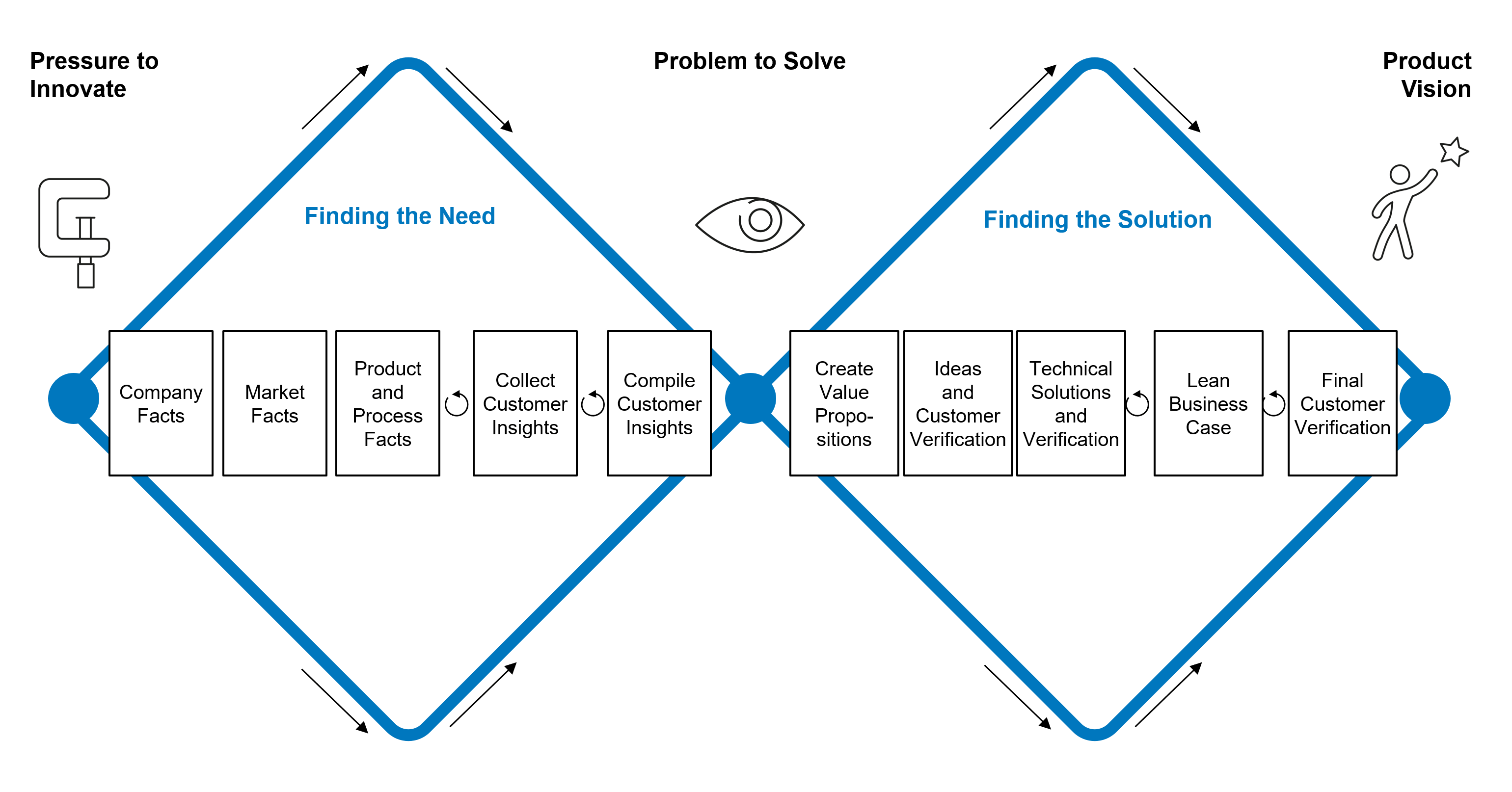What does ideation mean?
Ideation is a creative process that consists of generating ideas in order to solve a problem. Creativity, innovation, divergence, convergence and reflection are some of the words that are associated with the ideation phase.
Ideation is a major step in the design thinking method which corresponds to the production of ideas. It follows the problem definition phase and consists of relying on a range of creative exercises and tools to get the best out of each member of the team and approach a problem in an innovative way.
You have to be prepared to twist it all over the place and tackle angles that you might not have thought of at first glance. It can seem a bit challenging at first, but after all, it’s about thinking of different creative solutions to solve a problem and then choosing the best one. You’ll see that working as a team will make the task much easier than it seems.
What is product ideation?
Product ideation is a strategic process that is part of design thinking which consists in organizing sessions with a group of people or team to take advantage of the different points of view, experiences, ideas and knowledge of each participant.
It can involve developers, architects, product users, designers, etc. It revolves around teamwork and collaboration and generally focuses on a specific product.
Why is product ideation important?
Product ideation leverages the contributions of team members in order to create innovative products based on the experience and perspectives of different people. Usually, the team stays aligned around a common goal and generates new ideas to create interesting and successful products.
What is the purpose of ideation?
The ideation method is 100% user-oriented. Therefore, the products and services generated through design thinking create added value to people for customers. The current boom and popularity of design thinking comes from its ability to generate innovative solutions in a very short time.
What are the steps in ideation?
A design thinking process involves different stages to which you can return as many times as you need, as long as you go through each of them at least once.
The different stages of the process are:
- Empathize
- Define
- Ideate
- Prototype
- Test
1. Empathize
You must never forget that your focus is to design something that is user-oriented and improves the UX. That being said, it makes sense that the first stage of the process is to put yourself in the shoes of the end user and try to understand what he/she really cares about.
The more your team empathizes, the easier it will be to understand users and know how to bring value to them. This stage is vital, because if you can gather enough information about the users and understand them deeply, it will be much easier to find solutions to solve their problems.
What techniques help in the empathizing process?
- Benchmark
- Interviews
- Shadowing
- Focus groups
- Research through Google
2. Define
Defining is one of the hardest parts of the whole process. Finding the right insights is very important in order to succeed.
In this part of the process, you must define a specific focus, which includes aspects that you have detected as relevant to the user. This will allow you to focus and not jump from one problem to another.
The process of defining involves finding the key needs and desires of the user and understanding the underlying reasons behind them.
3. Ideate
In this stage, you have to begin to create solutions for the specific problem that you have defined. To define your creative idea, you have to ask a question that is directly linked to the focus you have chosen.
For example, let’s imagine that the problem you are focusing on is that old people feel alone during the week. A question that you could ask yourself to find a solution could be something like this: How can I make the elderly not feel alone during the week?
How can you generate ideas? The best known and most common method is brainstorming. Here are some tips to make the brainstorming session a resounding success: adjust the focus, make the moment enjoyable and fun, dare to come up with crazy ideas, don’t judge, be visual, write down all the ideas and number them, make sure there is only one conversation at a time and don’t lose sight of the question for which you are generating ideas.
4. Prototype
In the prototyping stage, you are going to bring your ideas to life.
Here are different ways to prototype:
- Role play: To prototype, sometimes we just need to explain how to use a product or service. In this case, what you have to do is simulate the interaction without neglecting the characteristics that are relevant to the user.
- Storyboard: This graphic prototype represents the user’s interaction with the product or service. It is useful to understand the functionalities and how they solve the user’s needs. It is not necessary to make large illustrations, simply make drawings that allow a clear understanding of what each vignette represents.
- Product plan: In this case, a design is drawn up in which the characteristics of the product or service are represented.
- Pamphlet: It serves to explain the information in an organized way, with text and photos. It is best to use the brochure in advanced stages of prototyping a product or service. If it includes the communication tone or the brand identity, even better.
Screenshots: With the correct screenshots, you can say everything you need about the product or service you have devised and even explain how it could be integrated into a website. You can also consider prototyping with landing pages, websites, case studies, and videos.
5. Test
Testing is the phase in which you show the user what you’ve designed for them. The most important thing when testing the product or service with users is to gather the most information possible to determine if you are really solving their needs and desires. Listen to their feedback instead of trying to sell them the idea.
After validating, there are different scenarios you can face…
If the feedback has been really positive, you can start with the production stage! If the feedback has shown you things you can improve and what things work very well, you can iterate and rework some aspects until you have a new validation. If for any reason, you realize that there is no market for the product or service that you have devised, you may have to abandon the process.
How to prepare for an ideation session
When you prepare for an ideation workshop, you must take into account certain aspects to make the best out of it. Inviting the right people to the session will give you different points of view. Make sure to choose the 7 or 10 team members that will participate well.
Choosing a facilitator will also make everything flow more easily. This person will be in charge of explaining the topic, timing, organizing the itinerary and writing down the ideas.
Picking the best location for the session is also really important. It has to be a comfortable place for everyone – inspiring, spacious and, if possible, something out of the ordinary. It’s also a good idea to incorporate elements that are associated with the topic you are dealing with.
Also try to prepare a list of questions about how you could solve the problem and break the ice with a game so that everyone feels more relaxed! Don’t forget to choose the ideation techniques you will use in order to make the session more effective and organized.
Examples of product ideation models
These product ideation work frames will come in handy for your Design Thinking process. Check them out and pick the one that suits you better!
(images)
Benefits of Design Thinking
It focuses on the people
One of the great advantages of design thinking is that it allows you to get to know our customers and discover their needs. It’s a UX-oriented method.
It turns problems into opportunities
It not only allows problems to be well defined, but also turns them into opportunities. In fact, thanks to this methodology, finding innovative and creative solutions for possible business solutions is quite simple. Win-win!
Reduced risk
It’s also important to bear in mind that thanks to design thinking, risks can be reduced. This is because all the factors that are present in the development ecosystem are taken into account: technology, market, competition, customers, suppliers, etc.
It focuses on the aspects that really matter to the end-user
Companies can focus on the aspects that truly matter to the users, at a functional or emotional level. And not only that, but it allows them to quickly conceptualize and test new concepts before making the final decision to develop them. As a result, products are 100% aligned with the desires of the consumers, and this sort of guarantees success!
It’s ideal for teamwork
The main advantage is that it allows you to bring together different profiles with different views: designers, executives, developers, marketing experts, etc. All of them can contribute enormously in the process.
Have a project in mind?
FAQ SCHEMA

* Source : Helbling
Contact-us

